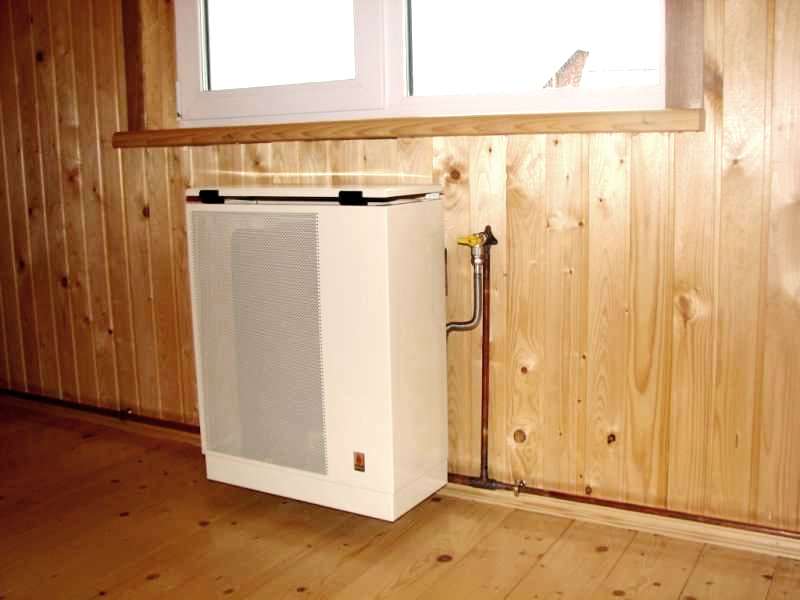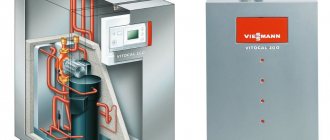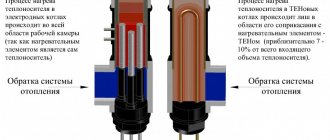Types of gas heating convectors
There are three types of gas convectors:
- Permanent installation: With a closed combustion chamber (parapet).
- With an open combustion chamber (chimney).
At first glance, mobile gas convectors seem to be the best solution. Maybe this is so, because a new principle of generating heat is used. They are a casing on wheels, in which a bottle with liquefied gas (optionally, it can be installed outside), a catalyst and the gas radiator itself are packed. There are not many such models. So far, there are only Italian Bartolini on our market (Primavera and Pullover models).

Mobile gas convector
This device is called "catalytic gas heater". It does not use conventional combustion, but catalytic decomposition (combustion on the surface of solids). Due to this, the usual exhaust and smell are absent, and the gas decomposes almost completely. Since such devices are used in Europe, there is no reason to doubt their reliability. But, so far, they are not very popular - the option with combustion without exhaust seems too incredible. In addition, even catalytic oxidation requires oxygen. And, therefore, it is taken from the air that is in the room. Well, then, when the catalyst runs out, will you have to buy it? Or completely change the device? In general, there is no real operating experience yet. But about the other two types of gas convectors - parapet and chimney - let's talk in more detail.
With an open combustion chamber
Gas convectors with an open combustion chamber use oxygen dissolved in the air for combustion. Therefore, the room must be equipped with full ventilation. A chimney is required to remove the combustion products. That is, the connection is like a traditional boiler of the same type or a gas water heater. Gas convectors with a closed combustion chamber have an efficiency of about 80%. This is 10-15% lower than most units with a closed combustion chamber.
If you decide to replace a boiler or a column, buy a gas convector with an open combustion chamber and connect it to the existing communications. But usually few people want to build everything anew. Indeed, for air heating with convectors, one device must be installed per room. It is costly and troublesome to remove such a number of pipes. The second option is to install a more powerful heater, with air duct routing in several rooms. But here a design solution is required, since it is necessary to accumulate heated air somewhere, and then distribute it to other rooms. Otherwise, it will be too hot in the room where the powerful convector is installed.


Chimney type gas convector with open combustion chamber
Gas convectors with an open combustion chamber also have advantages:
- work more stably (with a properly arranged chimney and sufficient draft);
- can have a large capacity (used for heating industrial, commercial and office buildings);
- there is no deterioration in thermal insulation and sound insulation (when installing parapet models, a hole must be made in the wall).
In general, a good option if you need to organize heating of a small country house, garage, workshop, greenhouse, etc.
Choice
When choosing a cylinder gas convector, first of all look at the technical characteristics of the heaters.As already noted, the most optimal option is a device with a cast-iron heat exchanger and a programmable control unit.
However, if you decide to purchase a similar unit, then be sure to take into account such indicators as:
- Power calculation. Since air convection occurs when the room is heated, such heaters are effective only in a limited space, for each separate room, you will need to install a separate convector.
- Housing type. Units equipped with a closed combustion chamber and a coaxial chimney are perfect for apartments; in a private house, absolutely any type of device can be mounted.
- Type of fuel. A gas convector that runs on liquefied gas is not allowed to be installed in an apartment in a multi-storey building. This is due to the high explosion hazard of the cylinders.
A gas convector for 1 kW of power consumes 90 grams of propane.
All convectors are initially manufactured taking into account the possibility of connecting to the main gas pipeline. If you want to connect the device to a cylinder, then you need to take care of the presence of a special reducer.
Choose a convector based on the area of the room and your financial capabilities. It is not worth buying a unit with a high power for a small room. This will give nothing but overheating of air and excessive gas consumption.
You can read about the operation of the natural gas convector here.
Parapet gas convector
A parapet is a gas convector with a closed chamber and a coaxial chimney. It is usually installed under the window - to block the zone of the most active intake of cold air. The chimney is led out through the wall. The hole is made at a certain point, which depends on the design of the model, but most often it is hidden behind the body of the heater. From the side of the room, the hole is covered with a metal plate, which is part of the mounting kit.
Gas radiators of this type are the most popular because they are easy to install and assemble. When they talk about gas convectors, they usually mean this type of equipment. And all because they can work both from natural and from bottled gas, oxygen for combustion is taken from the street, the exhaust is discharged there. The gas combustion chamber in parapet models, in relation to the room, is sealed, that is, the exhaust does not enter the room under any conditions. The peculiarity of this heating equipment is that it uses a coaxial chimney. It is also called "pipe in pipe".


The principle of operation of the parapet gas convector
The gas burner is located at the bottom of the heat exchanger. Air from the street enters the combustion zone through the outer pipe, exhaust air with combustion products is discharged through the inner pipe. Since the air flows are separated only by a layer of metal, the air coming from the street, as it moves, heats up. Therefore, units with a closed combustion chamber have a higher efficiency: less heat escapes into the pipe.
Principle and features of work
How is the indoor air heated? The air heated by the burner rises up along the walls of the heat exchanger, warming them up, then exits through the inner pipe of the coaxial chimney. The heated walls of the heat exchanger heat up the air that is nearby. For its active movement in the casing, which covers the heat exchanger, holes are made in the lower and upper parts. Cool air enters through the lower ones, rises up, heats up from the heat exchanger body, and exits through the upper holes.


A gas convector for heating a garage is an almost ideal solution
Some models have built-in fans for more active heating. But the fan can be attached by yourself.But the blowing mode creates a very active air movement, so it may even feel cooler. Especially if you are in a zone of passage of air currents.
Advantages and disadvantages
The advantages of the parapet gas convector are simple installation. There is no need to build a chimney. You just need to lead the pipe through the hole in the wall. But this - the hole in the wall - is also a disadvantage. First, the hole degrades the thermal insulation. Second, sound insulation decreases. If you stand at the opening, you can clearly hear what is being said in the room.


For installation, you need to make a hole in the wall
The problem with thermal insulation can be solved - fill the gap with heat-resistant insulation (mineral wool with an operating temperature of + 500 ° C). They will slightly worsen the permeability of sounds, but it will not work to achieve the same level of sound insulation.
Gas convector - DIY installation
Only specially trained people will be able to install the gas heating convector in compliance with regulatory requirements and safety measures.
The basic requirements for safe installation are clear from the diagram Installation of the gas outlet pipe
Only professionals can install a gas heater-convector correctly.
How to conduct installation of a gas convector, video-instructions can be found here:
In general, gas heating convectors are an excellent alternative to both a central water heating system and an electric one.
Efficiency of the heating gas convector
How to choose the power
Each heating device, and a gas convector too, in the description has such a line as the recommended heated area. The data are given for "average" insulation and standard ceiling heights (up to 2.7 m). If your room goes beyond these parameters, you need to adjust the power up or down.


Power is one of the first selection criteria
If it is necessary to estimate the power of a gas convector in advance, the calculation is carried out by area: 1 kW of power is taken for 10 square meters. But this is if the insulation is "average" and the ceilings are 2.5-2.7 m. In case of differences, again we correct in one direction or another. And one more thing: it is better to take power with a margin of 20-25%. The benefit is twofold:
- in case of extreme cold weather, you will not freeze;
- the unit will almost never operate at the power limit, which will extend its service life.
If you need a more accurate calculation, taking into account the materials of the walls, the region, the location of the room, etc., you can find information here.
Similarities and differences between gas convectors and gas boilers
Power calculation
In order to calculate the required power required for heating a summer cottage with gas convectors, the same principle is taken as for electric heating. The average ceiling height in the room is 2.8 meters. For 1 sq. meter of room requires about 100 watts of thermal power of the device.
Thus, it turns out that for heating a room with an area of 20 sq. meters, you will need a gas heating converter with a capacity of 2 kW.
However, as practice shows, a small power reserve is always required. The thickness of the walls in the room, the number of windows, the outside air temperature, and more are taken into account.
Other selection options
Gas convectors of low power (up to 10 kW), can be wall-mounted, and can be installed on the floor. The more powerful ones are always floor-standing. This is due to weight - a heavy unit may not be able to stay on the wall. Wall-mounted models are supplied complete with brackets, floor-standing ones are equipped with legs.


Floor-standing models look good too
Heat exchanger
The efficiency of the unit depends on the shape and material of the heat exchanger. As a rule, heat exchangers are made of cast iron or steel. Cast iron are more reliable, but they are heavier and more expensive.If the wall has a bearing capacity constraint, weight can be critical. In other cases, it is better to purchase products with cast iron heat exchangers. But during operation, it is necessary to exclude the ingress of water on the hot surface of the cast iron - even a few drops of cast iron can crack.


Although the heat exchanger is covered with a casing, water can enter through the holes
The advantages of gas convectors with cast-iron heat exchangers include a longer service life, no noise during operation. In a steel heat exchanger, clicks occur due to thermal expansion. This happens when the metal heats up and cools down. In living rooms, the periodic appearance of extraneous sounds is very unpleasant.
But steel heat exchangers are made with glass inserts. The flame can be observed through this window. This, of course, is not such a pleasure as watching a flame in a fireplace, but it is still more pleasant than an ordinary piece of iron.


You can look at the flame while meditating
Burner type
A burner in a closed or open combustion chamber can be modulating or not. The modeled ones differ in that they smoothly adapt to the requirements of the current moment. But they are more expensive and should be controlled by more sophisticated automation. For this reason, a gas convector with a simulated burner will cost more than a similar unit with a burner that can only operate in two modes: 50% and 100%.
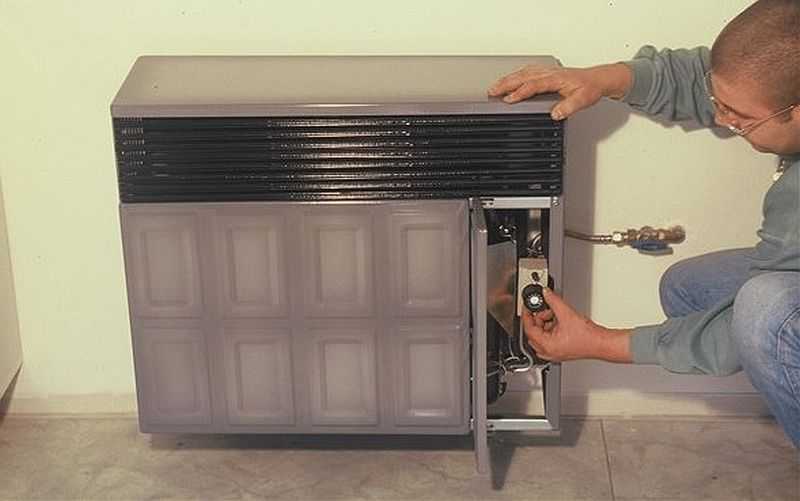

The appearance can be different
Which burner is the best? Simulated. What's better? There are several benefits. The first is gas savings, since the consumption is only in the amount that is needed. The second is accurate temperature maintenance. With a sudden change in temperature, this is convenient: do not wake up sweaty or frozen.
Ignition type
Gas burners are available with electronic ignition (volatile) and piezo ignition (non-volatile). Piezo ignition is an option with a pilot burner, i.e. a small light should always be on. When the machine is at rest, only the pilot burner is lit. When the main burner should turn on, it is ignited by the pilot.


Better and more economical simulated burner
A gas convector with a pilot burner has two pluses and two minuses. First, the pros: such a gas convector is cheaper and works regardless of the availability of electricity. The cons are as follows:
- It consumes about 25% more gas (the pilot burner must always be on).
- Less stable work. If the pilot burner is off, the unit will not start. And it can go out due to clogging, accumulated carbon deposits, lack of traction and a dozen other reasons. It can also be blown out by the wind, etc.
Please note that when choosing a location for installing a gas convector with a coaxial chimney, the prevailing wind direction must be taken into account. It is advisable to choose a place where the wind blows infrequently and / or lightly during the cold season. On the side of the prevailing winds, a plate can be placed to prevent blowing out. But all this should be borne in mind before buying a heating device.


This is what the chimney will look like outside.
Gas convection heaters with electronic ignition are good in that a spark is issued by a control command. That is, it is also extracted using a piezo or electric lighter, but only at the moment when it is necessary to ignite the gas. This means less gas consumption, more stable operation. But the minus is the need for electricity. If power outages are rare for you, this should not scare you. If the lack of power supply is not so uncommon, it is better to pair an uninterruptible power supply unit with a rechargeable battery. The power consumption is very low, so you don't need to charge the battery often.By the way, in such models, after the power supply is restored (the duration does not matter), all user settings (that you have set) are saved. This means that after the appearance of electricity, the electronically controlled gas convector will analyze the situation by itself and start the convector or not.
Exhaust gas temperature
The temperature of the exhaust gases is an indirect indicator of the efficiency of the heating equipment. If the heat exchanger is designed well, if the casing is designed correctly, a significant part of the heat goes to heating the air in the room. If mistakes are made, you have to “drown the street”. So we also pay attention to this point.


Data are indicated for the most favorable conditions
The flue gas temperature is indicated in the model data. If this parameter is not specified in the characteristic, there is reason to assume that the efficiency of the device is too low.
Natural (main) or liquefied (bottled) gas
Almost all models of gas domestic convectors can work with both bottled and main gas. To switch from one type of fuel to another, it is necessary to replace the nozzle (differ in the size of the nozzle holes). Some also require readjustment. The process is described in the operating instructions, but if you are unsure of your own abilities, you can order a unit for a specific type of gas. Then it will come to you with the factory setting for the required type of gas.


When installed on a combustible wall, you must protect it with a non-combustible backing
Another point: when searching for models and comparing prices, pay attention to the package bundle. For some, the injector for the second type of fuel is included in the basic kit (models with two injectors are usually slightly more expensive), for others it must be purchased separately. If you may need both kits, it’s better to buy them together. If only one type of fuel is used, there is no point in overpaying for an unnecessary part.
Legal and technical details
Of course, when using main gas, heating costs are lower. It is still the cheapest fuel in our country. But it must be borne in mind that for the installation of a gas convector, just like for the installation of any other gas equipment, a certified project is required. And this is money, time. And the money, I must say, is sometimes considerable.


To install a gas convector on main gas, a project is required
And further. If you are going to heat several rooms in this way, then each one needs its own convector. And pipes will pull to it along the walls. Moreover, the gasket is only open, that is, they cannot be hidden under the casing. Only on top. The installation of a gas convector, powered by a gas cylinder, does not require a project (if gas is not supplied to the house at all. If there is a gas supply, the project is still necessary).
Features of the operation of gas cylinders
So, although it is more expensive to use bottled gas, it is easier. But this has its own peculiarities. A mixture of two gases, propane and butane, is pumped into the cylinder. Fractional matching is approximately 50/50. One gas evaporates well even at deep minus, the other at -40 ° C turns into a liquid state and practically does not evaporate. We don't have such severe frosts very often, but -20 ° C can last for weeks. In such a frost, the gas evaporates, but very slowly. And only one cylinder is allowed to be stored indoors. So that might not be very convenient either.
We advise you to additionally read the article "Heating with gas cylinders in a private house".
There may still be a shortage of gas at low temperatures and high flow rates. This is what usually happens. After all, the colder it is, the more heat is required, the higher the fuel consumption. To solve this problem, several cylinders are combined into a single system. In this case, the gaseous fraction is always sufficient.
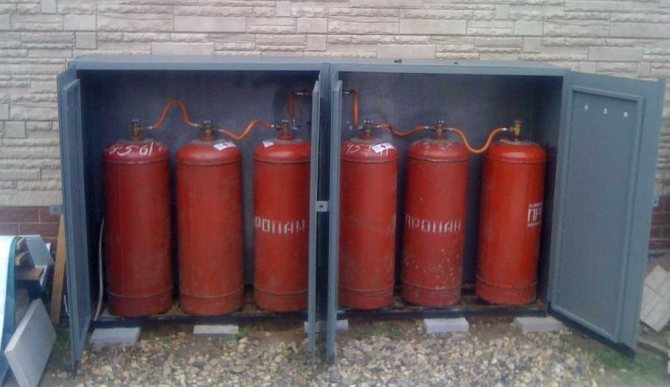

Combine several cylinders into one system
Additional features and options
Additional features and options are not always superfluous. Some "bells and whistles" make the use of a gas convector more convenient, reliable and safe. Others allow you to tailor the work to your own needs or increase safety.
- A thermostat, in one form or another, is in any gas convector. It turns off the device when the temperature near it reaches certain values. That is, the gas convector does not work around the clock, but only when the room temperature drops below the set one. Most units allow you to set the desired temperature in the range from + 13 ° C to + 38 ° C. Models with a lower "starting" temperature, you will have to look well.
- Programmable automation (electronically controlled). Allows you to adjust the operating mode by the hour (cooler at night, warmer by the time you get up, etc.). More "advanced" models can generally be customized by days of the week. The disadvantage is the higher price.
- Flame control. There is in any model, but it is better not to forget to check.
- Gas contamination control. Until recently, gas convectors were not allowed to be used in residential areas. In technical, please. In the bedrooms, no. Not so long ago, changes were adopted in which operation is allowed, subject to the presence of gas control. In order not to bother with the installation of the system, it is easier to buy a model with a control function. And safety is a sacred thing, even in technical rooms.
With the development of technology and technology, the list will increase. Surely there are already some new items, but they are not very popular yet - because of their price.


The gas convector is good for heating a garage, greenhouses on an ongoing basis, as an additional or main
Features of functioning
Cylinder gas heaters can differ in many ways. It is necessary to pay attention to the characteristics of the equipment, which will allow you to choose the right heater for the features of a particular structure and a private house.
Main characteristics:
- Availability of automatic control.
- Convention type.
- The presence or absence of a fan.
- The energy carrier used.
- Combustion chamber type.
- Installation power.
- Heat exchanger material.
Depending on the version, such heaters can be installed on the floor or mounted on the wall. Wall mounted models are highly efficient and lightweight. The power of wall-mounted convector heaters on liquefied gas can reach 10 kW, which allows them to heat large rooms. Floor-standing devices can be equipped with an enlarged heat exchanger, but their capacity usually does not exceed 5 kW.
When the operation of the boiler on propane is already dangerous:
Combustion chamber type
The combustion chamber can be closed or open. In recent years, models with a closed combustion chamber have become most popular, which ensures the highest possible efficiency and complete safety of equipment operation. Convectors with a closed combustion chamber can have a coaxial pipe instead of a classic chimney, which simultaneously takes in fresh air from the street and effectively removes the combustion products outside. The only drawback of convectors with a closed burner is their high cost.
Heat exchanger material
The material from which the heat exchanger is made will directly affect the durability, efficiency and reliability of the equipment. Convectors with heat exchangers made of cast iron and steel are on the market today. The most durable, reliable and durable devices are those made with a cast-iron heat exchanger. If used correctly, they will last for 50 years.The disadvantage is the high cost of models with cast iron heat exchangers.


Some convector models will last you longer than others
Convection type
Depending on their type, heating installations can use forced and natural convention. Heaters operating with a natural convention, practically do not emit noise, which allows them to be used in residential premises. The advantage of devices with forced convection is their improved performance and the ability to use such equipment for heating large rooms. Fuel consumption in a bottled gas convector can vary significantly depending on the power of the equipment and its type of convection.
Control automation
The offered gas convectors can be equipped with both the simplest automation, which includes only thermostats and control relays, and advanced logic, which provides maximum automation of the equipment operation. Depending on the used automation, the cost of heating installations will differ.
Correct power calculation
The universal formula for calculating power is 1 kW of thermal energy per 10 squares of room area. However, such calculations will be averaged and will not always allow you to choose the correct converter for a particular room. It is necessary to take into account the features of the structure, the height of the ceilings, the presence or absence of windows, high-quality insulation of the walls, as well as the climate in the region.
When choosing fully automated installations that have a compulsory convention, one can proceed from the calculation of 0.7 kW of thermal energy per 10 square meters of room area. They can be used as the main heating method only in small buildings. A propane gas convector will be the ideal solution for a wooden or brick cottage.








